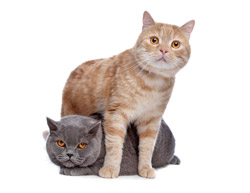 How pet insurance can help you foot the bills
How pet insurance can help you foot the bills
Pets have a knack for getting into some strange, and scary, situations. There are a million and one different ways your furry friend can find themselves in need of a trip to the vet:
- Poisonous plants
Lilies, Aloe, Periwinkle, Tulips, Daffodils, Azaleas, Lily of the Valley, and yes, marijuana are just a few examples of plants that can be hazardous to your pet. - That's not food
Some pets are like a vacuum; they'll eat anything: toys, tennis balls, sticks, socks, pillows...you name it, chances are a pet has tried to eat it. - Just because they have fur, doesn't make them friends
Reality often bites and scratches when a pet takes on a wild animal. - Every owner's, and driver's, worst nightmare
Pets hit by cars are unfortunately all too common.
Pet Insurance in Canada
It's not only misadventure that can send your pet to the vet. In fact, an unexpected trip to the vet will likely be a result of an illness. According to PetSecure, one of the featured pet insurance providers at Kanetix.ca, more than 75 per cent of pet insurance claims are due to illness. Whatever the reason—accident or illness—chances are you wouldn't think twice about taking your pet to the vet if your cat or dog needed medical attention. But, without pet insurance, this medical attention can be costly.
Should you buy pet insurance?
Veterinary medicine, like human medicine, has come a long way, which means—depending on the illness or injury—can come with a big price tag. A broken leg, hip problems, ear infections, swallowing weird things (toys? socks? tennis balls?), diabetes, urinary tract infections and more can all cost you in the thousands of dollars without pet insurance.
The chances your pet will need medical attention sometime during their life is likely; 1 in 3 pets require medical attention every year. Combine this, with the potential costs of veterinary care, and pet health insurance just makes sense.
When is the best time to buy pet insurance?
When your pet is still a kitten or a puppy, before any pre-existing conditions emerge, is the best time to buy pet insurance. That said, you can get pet insurance for almost any age of animal, and for pets with pre-existing conditions coverage can be obtained too; however, that particular illness or condition will likely be excluded from the protections of the policy.
About pet insurance
Pet insurance companies and policies vary—so it's wise to know exactly what you are, and are not, buying. Depending on the policy, you can get coverage for:
- Accidents
- Illnesses
- Dental
- Alternative therapies (massage etc.), behavioural therapies and medical devices
Pet insurance plans, whether it's for an illness or accident, will typically provide coverage that pays a portion of the cost of pet care including the vet's professional fees, hospitalization, surgery, diagnostics, x-rays, nursing, medication etc. With dental coverage, it can often include protection for not only dental illnesses but also preventative dental care for the teeth and gums too.
Some pet plans will even provide coverage for annual check-ups: exams, vaccinations, blood profiles, urinalysis, flea medication, fecal exam and deworming, and specific to dogs-heartworm tests and medication.
Pet insurance often has a co-insurance (or co-pay) component as well as a deductible. It's pretty standard: co-pay is the percentage of the pet insurance claim you pay before any deductible is applied. A deductible is a fixed amount you'll also pay, however, in many instances you pay this only once per year regardless of how many pet insurance claims you submit. This too may vary, so it's worth noting as you're reviewing pet insurance policies.
 Lastly, just like any insurance product, there are often limits. When comparing pet insurance plans look to see if there's a maximum payout per claim, or per year, or per policy.
Lastly, just like any insurance product, there are often limits. When comparing pet insurance plans look to see if there's a maximum payout per claim, or per year, or per policy.
Compare pet insurance quotes
No one should ever have to choose between the health of a beloved pet or the health of a bank account. Compare pet insurance quotes today.




